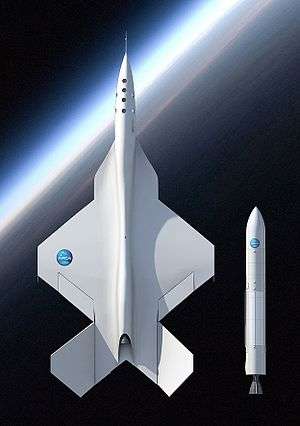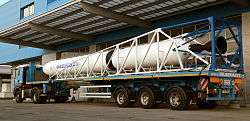Haas (rocket)

Haas is a family of rocket space launchers developed by the Aeronautics and Cosmonautics Romanian Association (ARCA) for the Google Lunar X Prize competition and for their national manned space program. It consists of Haas balloon-launched orbital rocket, Haas 2 airplane-launched orbital rocket, Haas 2b ground-launched suborbital rocket and Super Haas ground-launched orbital rocket.
It was named after Conrad Haas, a medieval rocket pioneer who lived and worked in what is now Romania, and was the first person to describe a multistage rocket in writing.[1]
Haas
Haas was a Romanian carrier rocket, which was developed by ARCA as part of the ELE programme. It was designed to be air-launched from a high-altitude balloon, similar to the American Rockoon experiments of the 1950s. Prior to the development of Haas, ARCA had already launched two Stabilo rockets from balloons. It is fueled by hydrogen peroxide and bitumen.
The Haas rocket[1] was to be a three-stage rocket intended to be capable of placing 400 kilograms of payload into low Earth orbit. Its maiden flight was to carry the European Lunar Explorer spacecraft, ARCA's entry into the Google Lunar X-Prize, following a series of engine tests which began in 2009.
It was abandoned when ARCA decided to stop using solar and helium balloons for their space program.
Haas 2

Haas 2 is an orbital two-stage launcher intended to be carried under the fuselage of the IAR 111 supersonic plane. It is powered by the new Executor liquid-fueled rocket engine[2] under development at ARCA. Its intended launch altitude is approximately 17,000 m. It is intended to place a 400 kg payload into low Earth orbit.
Haas 2c

Haas 2c is a flight testing platform for the Executor engine. It was an intended single-stage-to-orbit vehicle due to its lightweight fuel tanks and, as of June 2012, had been planned for an early 2013 launch. ARCA announced that after the successful flight test of Executor engine, that they would construct a multi-stage rocket based on Haas 2c in order to win the Google Lunar X Prize competition. Engine tests are scheduled to begin in June 2012 [3]
General characteristics
- Length: 18 m
- Diameter: 1.2 m
- Empty weightl: 510 kg
- Weight with fuel: 16,000 kg
- Engine thrust: 230,000 N
- Engine burn time: 3 min
- Fuel burn rate: 85 kg/s

See also
References
- 1 2 ARCA Space, Haas Orbital Rocket Launcher fact sheet, Dec. 2, 2008 (accessed 22 Sept 2014)
- ↑ ARCA, Executor Rocket Engine (accessed 22 Sept 2014)
- ↑ "Haas 2C orbital rocket presented in Victory Square in Bucharest". Mediafax. Retrieved 2012-06-03.
External Pages
- "Haas Orbital Rocket Launcher" (pdf). ARCA. 2008-12-23. Retrieved 2008-12-25.
- "Romanian Space Program" (pdf). ARCA. 2012-02-25. Retrieved 2012-03-08.
| Wikimedia Commons has media related to HAAS. |